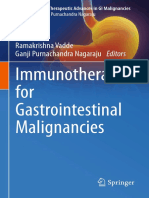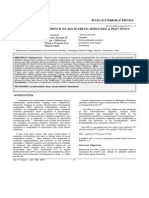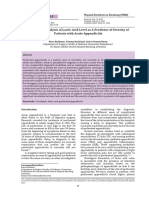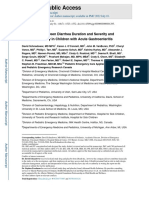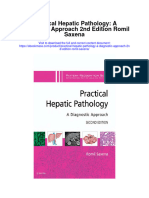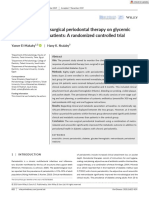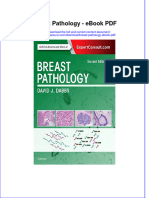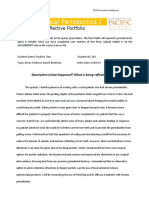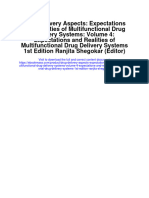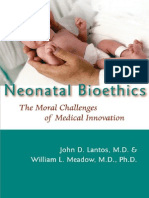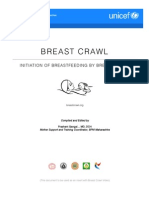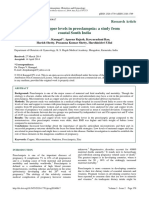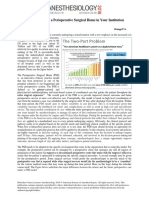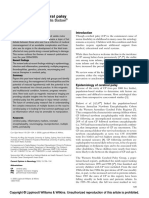Professional Documents
Culture Documents
C-Reactive Protein Level As A Diagnostic Tool For Assessment of Adverse Pregnancy Outcomes in Females With Periodontal Disease - A Randomized Clinical Trial
Original Title
Copyright
Available Formats
Share this document
Did you find this document useful?
Is this content inappropriate?
Report this DocumentCopyright:
Available Formats
C-Reactive Protein Level As A Diagnostic Tool For Assessment of Adverse Pregnancy Outcomes in Females With Periodontal Disease - A Randomized Clinical Trial
Copyright:
Available Formats
Volume 8, Issue 4, April – 2023 International Journal of Innovative Science and Research Technology
ISSN No:-2456-2165
C-Reactive Protein Level as a Diagnostic Tool for
Assessment of Adverse Pregnancy Outcomes in
Females with Periodontal Disease – A Randomized
Clinical Trial
First Author Second Author
Dr Rambhika Thakur Dr. Vikas Jindal
Reader Professor
Dept. of Periodontics Dept. of periodontics
MN DAV Dental College, Solan, Himachal Dental College, Sundernagar,
Himachal Pradesh, India Himachal Pradesh, India
Third Author Fourth Author
Dr Saroj Thakur Corresponding Author
Reader Dr. Pavan Kumar Gujjar
Dept. Of conservative dentistry and endodontics Prof and HOD
MN DAV Dental College, Solan Dept. of Oral pathology and microbiology
Himachal Prasesh, India Yogita Dental College and hospital
Khed, Maharashtra
India
Fifth Author Sixth Author
Dr. Jyoti Zingade Dr. Ajay Mahajan
Senior Lecturer Professor
Dept. Oral medicine and radiology Department of periodontics
Yogita Dental College and hospital HPGDC, Shimla
Khed, Maharashtra Himachal Pradesh
India India
Abstract:- Background: An acute-phase protein found in sent for laboratory analysis. CRP levels were determined
plasma that reflects a measure of acute phase response to using Immuno Turbidometry method on an autoanalyzer.
inflammation is C-reactive protein (CRP). Early detection Result It was found that the mean value of CRP levels is
of periodontal disease and its prediction can be used by correlated with high incidence of preterm delivery.
CRP. There is an association of C-reactive protein with Subjects with preterm delivery have high mean CRP
adverse pregnancy outcomes, including pre-eclampsia values as compared to subjects with normal delivery.
intrauterine growth restrictions, and preterm delivery. Conclusion Increased CRP levels in early pregnancy is
The present study endeavor to evaluate serum C-reactive associated with periodontal disease in pregnant women. In
protein level in pregnant women with and without healthy normal controls the incidence of preterm delivery
periodontal disease and to compare incidence of pre-term is lesser comparative to pregnant women with periodontal
delivery in pregnant women with and without periodontal disease.
disease .Material and methods This study was undertaken
in 40 pregnant women, divided into 2 equal groups of 20 Keywords: C-Reactive Protein, Periodontal Disease, Preterm.
pregnant women within 22nd weeks of gestation; group I
(study group) with periodontal disease and group II
(control group) without periodontal disease. Blood samples
were taken for estimation of C-reactive protein levels from
both the groups within 22nd weeks of gestation and were
IJISRT23APR1731 www.ijisrt.com 2440
Volume 8, Issue 4, April – 2023 International Journal of Innovative Science and Research Technology
ISSN No:-2456-2165
I. INTRODUCTION An Informed consent was obtained from all the patients.
C-reactive protein (CRP) is 120,000-140,000 molecular All the patients were followed through a post partum
weight pentameric protein. Tillett and Francis in 1930 visit to evaluate the incidence of preterm delivery.
discovered that , substance in the serum of patients exhibiting
acute inflammation, was found reacting with pneumococcus Laboratory analysis
capsular polysaccharide.[1] CRP is an acute phase reactant Estimation of C-reactive protein levels from both the
synthesized by liver in response to the inflammatory cytokines groups within 22nd weeks of gestation were done and sent for
like interleukin (IL)-6, IL-1, and tumor necrosis factor- laboratory analysis after blood samples were taken. CRP
alpha.[2] Systemic inflammation and periodontal diseases are levels were determined using Immuno Turbidometry method
indicated by circulating C-reactive protein [3],[4] There is a on an autoanalyzer. The detection limit of the test was 2.9
proportional increase of inflammation with increase in high mg/L and the biological reference interval was <5 mg/L.
sensitivity CRP levels[5] therefore the prediction and early
detection of periodontal disease is possible by the use of CRP Measurement of periodontal status
.[6]
Gingival inflammation [12]
[7]
Increased risk of preterm low birth weight, low birth Loe & Silness Gingival Index was used to know the
weight,[8] and preterm birth [9] has been associated with severity of gingivitis
periodontal disease. Therefore, C-reactive protein level can be
used as a diagnostic tool as a plausible mediator of association Probing depth
between periodontitis and adverse pregnancy outcomes. [10] The probing depth measurement was assessed by means
of University of Michigan “O” probe with Williams’s
Thus the aim and objective of the present study were to markings. Except third molars probing depth measurements
assess serum C-reactive protein level in pregnant women with were made at the mesio-buccal, buccal, disto-buccal, disto-
and without periodontal disease and to compare incidences of lingual, lingual, and mesio-lingual positions of every tooth.
preterm delivery.
Clinical attachment level
II. MATERIAL AND METHODS The distance between the base of the pocket and a fixed
point on the crown, such as the cementoenamel junction (CEJ)
Study was conducted in the Department of Obstetrics and was made to measure the clinical attachment level. Except
Gynaecology, Kamla Nehru state hospital for Mother and third molars Clinical attachment level measurements were
Child, Shimla and at Civil Hospital, Sundernagar, Himachal made at the mesio-buccal, buccal, disto-buccal, disto-lingual,
Pradesh. lingual, and mesio-lingual positions of every tooth.
Patients who participated in the study are of age group Community periodontal index of treatment needs (cpitn) [13],[14]
between 18-34 years, systemic healthy, Singleton pregnancy, It was noted using a CPITN probe. The ten specified
pregnant females within 22nd week of gestation were included. index teeth were recorded. These teeth have been identified as
History of antibiotic intake during pregnancy, periodontal the best estimators of the worst periodontal condition of the
therapy in the past six months, other risk factors like alcohol mouth and only one score, the highest is recorded.
consumption, smoking or drug use, multiple pregnancy,
pregestational diabetes, previously diagnosed uterine The obtained results were compiled and subjected to
anomalies, patients with medical history of cardiac disease and statistical analysis using SPSS software by a qualified
chronic renal disease, without access for communication and statistician.
correspondence address, having less than 18 teeth were
excluded. III. RESULTS
The 40 subjects who met the selection criteria were In this study, an attempt was made to evaluate the CRP
divided into study group (Group I) and the control group levels in pregnant women with and without periodontal
(Group II). A questionnaire was administered by the examiner. disease in subjects within a defined age group and similar
Information was obtained regarding socioeconomic status of body mass index. In group I (Study) the mean age of the
the patients from this questionnaire. Modified Kuppuswamy’s subjects was 24.8±4.66 years. In group II (Control) the mean
socioeconomic scale [11] was utilized in this study for the age was 25.3±2.29 years. In group I (Study) mean BMI of the
stratification of the patients. Five classes were stratified subjects was 20.70±2.95 kg/m2. In group II (Control) the mean
comprising of upper, upper-middle, lower-middle, upper- BMI was 20.86±2.95 kg/m2. There was a difference in mean
lower and lower. age of subjects in both the groups which were statistically
insignificant (p=0.67, p>0.05). The difference in mean BMI in
IJISRT23APR1731 www.ijisrt.com 2441
Volume 8, Issue 4, April – 2023 International Journal of Innovative Science and Research Technology
ISSN No:-2456-2165
the group I (Study) and the group II (Control) was statistically insignificant (p=0.86, p>0.05) (Table 1).
Table 1 Comparison of age and body mass index between group I (Study) and group II (Control).
Std.
Groups N Mean SD
Variable Error Mean
Cases 20 24.8 4.66 1.04
Age Controls 20 25.3 2.29 0.51
Cases 20 20.70 2.95 0.66
BMI (Kg/m2) Controls 20 20.87 2.95 0.66
Age: p=0.67, p>0.05 BMI: p=0.86, p>0.05
The majority of subjects enrolled in the study were from upper middle, 18 (45.0%), followed by lower middle, 14(35.0%), upper
lower, 7(17.50%) and 1(2.5%) from upper class. There was statistically significant (p=0.024, p<0.05) with the difference in
socioeconomic status between group I (Study) and group II (Control) (Table 2).
Table 2: Comparison of socioeconomic status between group I (Study) and group II (Control)
Cases Controls Total
Socioeconomic status
N (%) N (%) N (%)
Upper 1 (5.0%) 0 (0.0%) 1 (2.5%)
Upper middle 5 (25.0%) 13 (65.0%) 18 (45.0%)
Lower middle 9 (45.0%) 5 (25.0%) 14 (35.0%)
Upper lower 5 (25.0%) 2 (10.0%) 7 (17.5%)
Total 20 (100.0%) 20 (100.0%) 40 (100.0%)
2 = 14.6 & p=0.024, p<0.05
The incidence of preterm and term delivery in group I (Study) was 11(55.0%) and 9 (45.0%) respectively. The incidence of
preterm and term delivery in group II (controls) was 3(15.0%) and 17(85.0%) respectively. A statistically significant difference was
found in incidence of preterm and term delivery in the Study and Control group. The incidence of preterm delivery between group I
(Study) and group II (Control) was statistically significant (p=0.033, p<0.05). The incidence of term delivery between group I (Study)
and group II (Control) was statistically significant (p=0.05) (Table 3).
Table 3: The incidence of preterm and term delivery between group I (Study) and group II (Control).
Cases Controls Total
Incidence
N (%) N (%) N (%)
2 P value
Number of preterm% of Total 11 (55.0) 3 (15.0) 14 (35.0) 4.57 0.033**
Number of term % of Total 9 (45.0) 17 (85.0) 26 (65.0) 3.84 .05**
Total number % of Total 20 (50.0) 20 (50.0) 40 (100.0)
** Significant at 0.05 level of significance
The mean value of C-reactive protein level in group I (Study) was 13.2±10.0 mg/L. The mean value of C-reactive protein level
in group II (Control) was 5.5±4.2 mg/L. The difference in mean CRP level was statistically significant (p=0.002, p<0.05) (figure 1).
The mean value of C-reactive protein level of group I (Study) with normal (Term) delivery was 4.94±3.24 mg/L. The mean value
of C-reactive protein level of group I (Study) with preterm delivery was 20.02±8.32 mg/L. The difference in mean value of CRP level
in term and preterm delivery in group I (Study) was found to be statistically significant (p=0.00, p<0.01) (Table 4).
Table 4: Comparison of mean C-reactive protein level (mg/L) in subjects of group I (Study) with normal (Term) and preterm delivery
(Unpaired t-test).
Cases N Mean SD Std. Error Mean t df P value
CRP level in term delivery 9 4.94 3.24 1.08
CRP level in preterm delivery 11 20.02 8.32 2.51 5.11 18 0.00*
* Significant at 0.01 level.
IJISRT23APR1731 www.ijisrt.com 2442
Volume 8, Issue 4, April – 2023 International Journal of Innovative Science and Research Technology
ISSN No:-2456-2165
The mean value of C-reactive protein level of group II (Control) with normal (Term) delivery was 4.85±3.07 mg/L. The mean
value of C-reactive protein level of group II (Control) with preterm delivery was 8.23±9.97 mg/L. The difference in mean value of
CRP level in term and preterm delivery in group II (Control) was found to be statistically significant (p=0.03, p<0.05) (Table 5).
Table 5: Comparison of mean C-reactive protein level (mg/L) in subjects of group II (Control) with normal (Term) and preterm
delivery (Unpaired t-test).
Std. Error
Controls N Mean SD t df P value
Mean
CRP level in term
17 4.85 3.07 0.74
delivery
CRP level in preterm 2.23 18 0.03**
3 8.23 9.97 5.10
delivery
** Significant at 0.05
The results of this cohort study demonstrate the elevated to Mokeem et al [19],Cruz et al [20]. There was a positive
CRP levels in pregnant women with periodontal disease association between periodontal disease and low birth weight.
compared to healthy controls and preterm delivery rate is The correlation between periodontitis and PTB/LBW were
higher in women with periodontal disease compared to control reported in several cross sectional studies. According to study
group. which was published in 2016 where women with PTB were
found to have worse periodontal parameters [21]. PTB is a
IV. DISCUSSION multifactorial condition and that periodontitis and the presence
of periodontal pathogens are not sufficient to trigger PTB
Even though there is advancement in obstetrical which was suggested in the year 2016 by Martinez- Martinez
prevention, diagnostics, and therapy preterm birth (birth et al. [22]. CRP levels exceeding the threshold that are
before 37 weeks of gestation) is still considered to be a major associated with increased risk of preterm delivery. [23] In the
problem and remains the leading cause of morbidity and present study, the mean value of reported CRP levels was
mortality [15]. An effort was made to assess the CRP levels in correlated with high incidence of preterm delivery. Subjects
pregnant women with and without periodontal disease in this with preterm delivery have high mean CRP values as
study. The elevated CRP levels in pregnant women with compared to subjects with normal delivery.
periodontal disease compared to healthy controls and preterm
delivery rate is higher in women with periodontal disease In this study, the association observed between CRP
compared to control group as a result of this cohort study. level and periodontal disease in pregnancy may or may not be
causal. Periodontal infection and inflammation may cause
The potential risk factors for preterm low birth weight elevated CRP levels. CRP amplifies the inflammatory
are estimated at the age less than 17 and more than 34. response through complement activation, tissue damage, and
However the subjects who participated in the present study are induction of inflammatory cytokines in monocytes [2] and
between 19-34 years of age, the mean age being 24.8 years, therefore may mediate the association between periodontitis
yielding no significant difference in mean ages in both the and adverse pregnancy outcomes.
groups. Mean age of the present study is compared with the
mean age of subjects in studies done by Offenbacher et al [7], This raises the possibility that CRP may mediate
Hasegawa et al [16] and Dongming et al [17] The difference in association between periodontal disease and preterm delivery.
mean BMI in both the groups was statistically insignificant However, during the interpretation of data one has to be
(p>0.05). There was a statistically insignificant relationship cautioned, as there is multi-factorial etiology of both
between preterm birth and body mass index between the periodontal disease and preterm delivery, in addition the role
present study as well as the study done by Hasegawa et al [16] of confounding effect can’t be completely excluded.
.
Our present study had several strengths. First, as the
The difference in mean socioeconomic status between relationship between multiple gestations and preterm labor is
the cases and the controls is found to be statistically well established subjects with only singleton gestation were
significant (p<0.05). According to the study done by Radnai included.[24] Second, there is a free access to all the
et al [18] the data showed insignificant difference as the preterm participants in medical and prenatal medical care. Third, the
birth was more common amongst women who were less temporal relationship between elevated maternal serum CRP
educated and had lower social status.Delivering a premature, concentrations and subsequent risk of preterm delivery was
low weight baby increases fourfold increase of periodontal determined by CRP status using serum collected in early
disease prevalence, regardless of the control of other risk pregnancy. However, our study also had some limitations.
factors such as age, smoking, and social extraction according First, based on the social factors the subjects in our study were
IJISRT23APR1731 www.ijisrt.com 2443
Volume 8, Issue 4, April – 2023 International Journal of Innovative Science and Research Technology
ISSN No:-2456-2165
relatively non-homogenous. Second, a single measurement of [11]. Newman JF, Gift HC. Regular pattern of preventive
serum CRP is not likely to provide a time-integrated measure dental services: A measure of access. Soc Sci Med
of maternal inflammation status during the index pregnancy. 1992;35:997-1001.
Third, a relatively small number of subjects were included in [12]. Newman, Takei, Klokkevold, Carranza. Clinical
the study. Periodontology-10th Ed. Gingival Index, 115-6.
[13]. Ainamo J, Barmes D, Beagrie G, Cutress T, Martin J,
At the end of the study the association of CRP with Infirri JS. Development of the world health organization
preterm delivery couldn’t be established conclusively. Future (WHO) Community Periodontal Index of Treatment
studies on the maternal and fetal immune response to chronic Needs (CPITN). J. Ainamo 32 (3): 281-91.
oral infection should be done to determine whether the [14]. Soben Peter. Essentials of preventive and community
relationship between periodontal disease and preterm is causal dentistry 2nd EdCPITN index, 174-82.
or simply associative. [15]. Bosnjak A, Relja T, Vucicevic BV, Plasaj H, Plancak D.
Preterm delivery and periodontal disease: a case-control
REFERENCES study from Croatia. J Clin Periodontol 2006; 33: 710-6.
[16]. Hasegawa K, Furuichi Y, Shimotsu A. Association
[1]. Tillett WS Francis T. Serological reactions in pneumonia between systemic status, periodontal status, serum
with non protein fraction from pneumococcus. J.Exp cytokine levels and delivery outcomes in pregnant
Med; 52: 561-85. women with a diagnosis of threatened premature labor. J.
[2]. Gabay C, Kushner I. Acute-phase proteins and other Periodontol 2003; 74: 1764-70.
systemic responses to inflammation. N Engl J Med 1999; [17]. Lin D, Moss K, Beck JD, Hefti A, Offenbacher S.
340: 448-54. Persistently high levels of periodontal pathogens
[3]. Slade GD, Offenbacher S, Beck JD, Heiss G, Pankow JS. associated with preterm pregnancy outcome. J
Acute-phase inflammatory response to periodontal Periodontol 2007; 78: 833-41.
disease in the US population. J Dent Res 2000; 79: 49- [18]. Radnai M, Gorzo I, Nagy E, Urban E, Novak T, Pal A. A
57. possible association between preterm birth and early
[4]. Noack B, Genko RJ, Trevisan M, Grossi S, Zambon JJ, periodontitis. J Clin Periodontol 2004; 31: 736-41.
De Nardin E. Periodontal infections contribute to [19]. Mokeem SA, Molla GN, Jewair TS. The prevalence and
elevated systemic C-reactive protein level. J Periodontol relationship between periodontal disease and preterm low
2001; 72: 1221-7. birth weight infants at King Khalid University Hospital
[5]. T. Bansal, D. Dhruvakumar, and A. Pandey, in Riyadh, Saudi Arabia. J Contemp Dent Pract. 2004; 5
“Comparative evaluation of C-reactive protein in (2): 40-56.
peripheral blood of patients with healthy gingiva, [20]. Cruz SS, Costa MCN, Gomes Filho IS , Vianna MIP,
gingivitis and chronic periodontitis: a clinical and Santos CT. Maternal periodontal disease as a factor
particle-enhanced turbidimetric immuno-analysis,” associated with low birth weight. Rev Sauda Publica.
Journal of Indian Society of Periodontology, vol. 18, no. 2005; 39 (5): 782-7.
6, pp.739–743, 2014. [21]. Perunovic N,Rakic MM, Nikolic LI,Jankovic
[6]. M. Shojaee, M. Fereydooni Golpasha, G.Maliji, A. SM,Aleksic ZM,Plecas DV,et al. The association
Bijani, S.M. Aghajanpour Mir, and S. N. Mousavi Kani, between periodontal inflammation and labor
“C-reactive protein levels inpatientswith periodontal triggers(elevated cytokine levels) in preterm birth:a
disease and normal subjects,” International Journal of cross-sectional study.J Periodontal (2016)87(3)248-56.
Molecular and Cellular Medicine, vol. 2, no. 3, pp. 151– [22]. Martinez –Martinez RE,MorenocastilloDF,Loyola –
155, 2013. Rodriguez JP,Sanchez-Medrano AG, Miguel-Hernandez
[7]. Offenbacher S, Katz V, Fertik G. Periodontal infection as JH ,Olvera- Delgado JH, et al. Association between
a possible risk factor for preterm low birth weight. J periodontitis,periodontopathogens and preterm birth: is it
Periodontol 1996; 67 (Suppl.): 1103-13. real?Arch Gynecol Obstet(2016) 294(1):47-
[8]. Dasanayake AP. Poor periodontal health of the pregnant 54.10.1007/s00404-015-3945-1
woman as a risk factor for low birth weight. Ann [23]. Pitiphat W, Gillman MW, Joshipura KJ, Williams PL,
Periodontol 1998; 3: 206-12. Douglass CW, Rich-Edwards JW. Plasma C-reactive
[9]. Jeffcoat MK, Geurs NC, Reddy MS, Cliver SP, protein in early pregnancy and preterm delivery. Am J
Goldenerg RL, Hauth JC. Periodontal infection and Epidemiol 2005; 162: 1108-13.
preterm birth: Results of a prospective study. J Am Dent [24]. Berkowitz GS, Papiernik E. Epidemiology of preterm
Assoc 2001; 132: 875-80. birth. Epidemiol Rev 1993; 15: 414-43.
[10]. Waranuch Pitiphat, Kaumudi J, Joshipura, Janet W,
Rich-Edwards, Paige L Williams, Chester W Douglass,
Matthew W Gillman. Periodontitis and plasma C-
reactive protein during pregnancy. J Periodontol 2006;
77: 821-5.
IJISRT23APR1731 www.ijisrt.com 2444
You might also like
- Leifer Chapter 08 Study Guide Answer KeyDocument5 pagesLeifer Chapter 08 Study Guide Answer KeyTyler Finkle81% (21)
- Avery's Neonatology PDFDocument3,845 pagesAvery's Neonatology PDFviaviatan100% (3)
- Leader Q DelegationDocument13 pagesLeader Q Delegationedoble100% (1)
- Obs Gynae Full Summary NotesDocument41 pagesObs Gynae Full Summary NotesJana Aldour100% (1)
- Planning and Design of Healthcare Facilities ReportDocument30 pagesPlanning and Design of Healthcare Facilities Reportjiabest1314No ratings yet
- Interventions To Improve Oral Vaccine PerformanceDocument12 pagesInterventions To Improve Oral Vaccine PerformanceSimbakutty VenkataramananNo ratings yet
- PeriodontitisDocument7 pagesPeriodontitisDanni MontielNo ratings yet
- 16 TH JC - SindhuDocument8 pages16 TH JC - SindhuDadi SindhuNo ratings yet
- Antibiotic Prophylaxis in The Surgical ManagementDocument7 pagesAntibiotic Prophylaxis in The Surgical ManagementRAHUL SHINDENo ratings yet
- Periodontal Status in Pregnant Women in Comparison With Non-Pregnant IndividualsDocument4 pagesPeriodontal Status in Pregnant Women in Comparison With Non-Pregnant IndividualsnurainiNo ratings yet
- Association Between Periodontal Pathogens and SeveDocument9 pagesAssociation Between Periodontal Pathogens and Sevepennyshevlin1No ratings yet
- JIG Vol 1 No 4 Oktober 2023 Hal 16-26Document11 pagesJIG Vol 1 No 4 Oktober 2023 Hal 16-26Tasya YohanaNo ratings yet
- (Mebooksfree Net) Imm&Gas&Mal&1stDocument257 pages(Mebooksfree Net) Imm&Gas&Mal&1stMilton BaltodanoNo ratings yet
- Research Articles Annals and Essences of DentistryDocument3 pagesResearch Articles Annals and Essences of DentistryvasabakaNo ratings yet
- Guzman 2018Document8 pagesGuzman 2018subbumurugappan94No ratings yet
- Periodontal Disease and Adverse Pregnancy OutcomeDocument3 pagesPeriodontal Disease and Adverse Pregnancy OutcomeWilliam JensenNo ratings yet
- Sahrmann 2010Document12 pagesSahrmann 2010Dragos CiongaruNo ratings yet
- 1 s2.0 S0300571222003098 MainDocument8 pages1 s2.0 S0300571222003098 MainRizki Yuli amandaNo ratings yet
- JIntClinDentResOrgan62103-2760784 074007Document4 pagesJIntClinDentResOrgan62103-2760784 074007daniel_siitompulNo ratings yet
- 2816 20588 1 PBDocument4 pages2816 20588 1 PBfilda d5No ratings yet
- Association Between Diarrhea Duration and Severity and Probiotic Efficacy in Children With Acute GastroenteritisDocument19 pagesAssociation Between Diarrhea Duration and Severity and Probiotic Efficacy in Children With Acute Gastroenteritis0019 Azhar WicaksonoNo ratings yet
- Wjoud 11 221Document5 pagesWjoud 11 221ReshmaaRajendranNo ratings yet
- O RadsDocument15 pagesO RadsMurilo Campos100% (1)
- Assessment of Knowledge, Attitude, Practice, Awareness Level of Periodontal Health and Adverse Outcomes Among Pregnant Women - A Questionnaire StudyDocument7 pagesAssessment of Knowledge, Attitude, Practice, Awareness Level of Periodontal Health and Adverse Outcomes Among Pregnant Women - A Questionnaire StudyInternational Journal of Innovative Science and Research TechnologyNo ratings yet
- Preeclampsia Screening Evidence Report and Systematic Review For The US Preventive Services Task ForceDocument16 pagesPreeclampsia Screening Evidence Report and Systematic Review For The US Preventive Services Task ForceRoberto López MataNo ratings yet
- KrithikaDocument95 pagesKrithikaTeja FloraNo ratings yet
- Aliment Pharmacol Ther - 2022 - Piovani - Meta Analysis Use of Proton Pump Inhibitors and Risk of Gastric Cancer inDocument13 pagesAliment Pharmacol Ther - 2022 - Piovani - Meta Analysis Use of Proton Pump Inhibitors and Risk of Gastric Cancer inlaksonoNo ratings yet
- Informatics in Medicine Unlocked: SciencedirectDocument4 pagesInformatics in Medicine Unlocked: SciencedirectJain KasparNo ratings yet
- Pjms 29 1112Document4 pagesPjms 29 1112Diana IancuNo ratings yet
- 1379 PDF PDFDocument7 pages1379 PDF PDFAnjana J PrathapNo ratings yet
- 1379 PDFDocument7 pages1379 PDFbalusaichanduNo ratings yet
- Journal of Population Therapeutics & Clinical PharmacologyDocument16 pagesJournal of Population Therapeutics & Clinical PharmacologyRashmita NayakNo ratings yet
- Experimental Gingivitis, Bacteremia and Systemic Biomarkers - A Randomized Clinical TrialDocument6 pagesExperimental Gingivitis, Bacteremia and Systemic Biomarkers - A Randomized Clinical TrialM HNo ratings yet
- Practical Hepatic Pathology A Diagnostic Approach 2Nd Edition Romil Saxena All ChapterDocument67 pagesPractical Hepatic Pathology A Diagnostic Approach 2Nd Edition Romil Saxena All Chapterpaul.wells767100% (5)
- Assessment of Gingival Biotypes in Patients Visiting A Tertiary Care Centre in Eastern NepalDocument6 pagesAssessment of Gingival Biotypes in Patients Visiting A Tertiary Care Centre in Eastern NepalHarish ShahNo ratings yet
- Diagnostic Efficacy of Cone Beam Computed Tomography in Paediatric Dentistry: A Systematic ReviewDocument20 pagesDiagnostic Efficacy of Cone Beam Computed Tomography in Paediatric Dentistry: A Systematic ReviewJoe TorresNo ratings yet
- BJOG - 2022 - Weelden - The Effect of Progestin Therapy in Advanced and Recurrent Endometrial Cancer A Systematic ReviewDocument10 pagesBJOG - 2022 - Weelden - The Effect of Progestin Therapy in Advanced and Recurrent Endometrial Cancer A Systematic ReviewAnonymous l6Q1ROq2No ratings yet
- Secdocument - 61download Breast Pathology 2Nd Edition David J Dabbs Full ChapterDocument67 pagesSecdocument - 61download Breast Pathology 2Nd Edition David J Dabbs Full Chapterjulia.swanson282100% (3)
- Lancet 2019Document11 pagesLancet 2019melinaparedes293No ratings yet
- Journal Reading Periodontitis and preeclampsia-BORDocument70 pagesJournal Reading Periodontitis and preeclampsia-BORbobbyrianto2210No ratings yet
- Comparative Evaluation of Serum High Sensitivity CDocument9 pagesComparative Evaluation of Serum High Sensitivity Catif nawazNo ratings yet
- Periodontal Diseases and Risk of Oral Cancer in Southern India: Results From The Hence Life StudyDocument8 pagesPeriodontal Diseases and Risk of Oral Cancer in Southern India: Results From The Hence Life Studyمحمد العراقيNo ratings yet
- 2.effect of Perioperative Oral Management On The PreDocument5 pages2.effect of Perioperative Oral Management On The PreJambul Wak Wak WakNo ratings yet
- Oral Contraceptive As A Risk Factor of Breast Cancer in Female Patients at Dr. Cipto Mangunkusumo National Public Hospital, Jakarta, IndoneDocument5 pagesOral Contraceptive As A Risk Factor of Breast Cancer in Female Patients at Dr. Cipto Mangunkusumo National Public Hospital, Jakarta, IndoneInternational Journal of Innovative Science and Research TechnologyNo ratings yet
- RCT (Randomized Control Trial)Document13 pagesRCT (Randomized Control Trial)yesicadeaNo ratings yet
- Kelompok 3Document9 pagesKelompok 3Yosep KurniawanNo ratings yet
- Oral Diseases - 2019 - El Makaky - The Effects of Non Surgical Periodontal Therapy On Glycemic Control in Diabetic PatientsDocument8 pagesOral Diseases - 2019 - El Makaky - The Effects of Non Surgical Periodontal Therapy On Glycemic Control in Diabetic Patientscristian quinteroNo ratings yet
- Management of HIVHepatitis Patients in Oral and Maxillofacial SurgeryDocument6 pagesManagement of HIVHepatitis Patients in Oral and Maxillofacial Surgerymehak malhotraNo ratings yet
- Comparative Study To Evaluate The Effectiveness of Aloe Vera and Metronidazole in Adjunct To Scaling and Root Planing in Periodontitis PatientsDocument4 pagesComparative Study To Evaluate The Effectiveness of Aloe Vera and Metronidazole in Adjunct To Scaling and Root Planing in Periodontitis Patientsnaimatus225No ratings yet
- Risk Assessment: A Mandatory Evaluation and Analysis of Periodontal Tissue in General Population - A SurveyDocument7 pagesRisk Assessment: A Mandatory Evaluation and Analysis of Periodontal Tissue in General Population - A SurveyAnonymous izrFWiQNo ratings yet
- Imaging Diagnostics in Pancreatic CanceDocument170 pagesImaging Diagnostics in Pancreatic CanceYuriy PerepelytsyaNo ratings yet
- Expression of Serum Survivin Protein in Diagnosis and Prognosis of Gallbladder Cancer-A Comparitive StudyDocument1 pageExpression of Serum Survivin Protein in Diagnosis and Prognosis of Gallbladder Cancer-A Comparitive StudyJaya Kunal DubeyNo ratings yet
- Infantile Hypertrophic Pyloric Stenosis at A TertiDocument7 pagesInfantile Hypertrophic Pyloric Stenosis at A TertiVașadi Razvan CristianNo ratings yet
- Ebook Breast Pathology PDF Full Chapter PDFDocument67 pagesEbook Breast Pathology PDF Full Chapter PDFmichael.daughtridge812100% (24)
- Winter Perio ReflectionDocument7 pagesWinter Perio Reflectionapi-506024957No ratings yet
- DR Anil Dissertation 2014Document144 pagesDR Anil Dissertation 2014Syed FurqanNo ratings yet
- Art 2Document21 pagesArt 2xdxdxdxdNo ratings yet
- Kees Tra 2014Document21 pagesKees Tra 2014Marco Antonio García LunaNo ratings yet
- Chairside Diagnosis of Periodontal Diseases A ReviewDocument4 pagesChairside Diagnosis of Periodontal Diseases A ReviewEditor IJTSRDNo ratings yet
- Prevalence of Caries and Periodontal Disease Among Indonesian Pregnant WomenDocument8 pagesPrevalence of Caries and Periodontal Disease Among Indonesian Pregnant WomenMaharani Dwi AprilianaNo ratings yet
- Download Drug Delivery Aspects Expectations And Realities Of Multifunctional Drug Delivery Systems Volume 4 Expectations And Realities Of Multifunctional Drug Delivery Systems 1St Edition Ranjita Shegokar full chapterDocument68 pagesDownload Drug Delivery Aspects Expectations And Realities Of Multifunctional Drug Delivery Systems Volume 4 Expectations And Realities Of Multifunctional Drug Delivery Systems 1St Edition Ranjita Shegokar full chapterjesse.yardley161100% (6)
- Evaluation of Salivary Calcium and Salivary ParathDocument5 pagesEvaluation of Salivary Calcium and Salivary ParathranisaNo ratings yet
- My Published PapersDocument8 pagesMy Published Papersshayma rafatNo ratings yet
- Ebook Practical Hepatic Pathology A Diagnostic Approach PDF Full Chapter PDFDocument67 pagesEbook Practical Hepatic Pathology A Diagnostic Approach PDF Full Chapter PDFalfred.delaney759100% (26)
- Recent Advances in Endometrial CancerFrom EverandRecent Advances in Endometrial CancerSumita MehtaNo ratings yet
- Cyber Security Awareness and Educational Outcomes of Grade 4 LearnersDocument33 pagesCyber Security Awareness and Educational Outcomes of Grade 4 LearnersInternational Journal of Innovative Science and Research TechnologyNo ratings yet
- Factors Influencing The Use of Improved Maize Seed and Participation in The Seed Demonstration Program by Smallholder Farmers in Kwali Area Council Abuja, NigeriaDocument6 pagesFactors Influencing The Use of Improved Maize Seed and Participation in The Seed Demonstration Program by Smallholder Farmers in Kwali Area Council Abuja, NigeriaInternational Journal of Innovative Science and Research TechnologyNo ratings yet
- Parastomal Hernia: A Case Report, Repaired by Modified Laparascopic Sugarbaker TechniqueDocument2 pagesParastomal Hernia: A Case Report, Repaired by Modified Laparascopic Sugarbaker TechniqueInternational Journal of Innovative Science and Research TechnologyNo ratings yet
- Smart Health Care SystemDocument8 pagesSmart Health Care SystemInternational Journal of Innovative Science and Research TechnologyNo ratings yet
- Blockchain Based Decentralized ApplicationDocument7 pagesBlockchain Based Decentralized ApplicationInternational Journal of Innovative Science and Research TechnologyNo ratings yet
- Unmasking Phishing Threats Through Cutting-Edge Machine LearningDocument8 pagesUnmasking Phishing Threats Through Cutting-Edge Machine LearningInternational Journal of Innovative Science and Research TechnologyNo ratings yet
- Study Assessing Viability of Installing 20kw Solar Power For The Electrical & Electronic Engineering Department Rufus Giwa Polytechnic OwoDocument6 pagesStudy Assessing Viability of Installing 20kw Solar Power For The Electrical & Electronic Engineering Department Rufus Giwa Polytechnic OwoInternational Journal of Innovative Science and Research TechnologyNo ratings yet
- An Industry That Capitalizes Off of Women's Insecurities?Document8 pagesAn Industry That Capitalizes Off of Women's Insecurities?International Journal of Innovative Science and Research TechnologyNo ratings yet
- Visual Water: An Integration of App and Web To Understand Chemical ElementsDocument5 pagesVisual Water: An Integration of App and Web To Understand Chemical ElementsInternational Journal of Innovative Science and Research TechnologyNo ratings yet
- Insights Into Nipah Virus: A Review of Epidemiology, Pathogenesis, and Therapeutic AdvancesDocument8 pagesInsights Into Nipah Virus: A Review of Epidemiology, Pathogenesis, and Therapeutic AdvancesInternational Journal of Innovative Science and Research TechnologyNo ratings yet
- Smart Cities: Boosting Economic Growth Through Innovation and EfficiencyDocument19 pagesSmart Cities: Boosting Economic Growth Through Innovation and EfficiencyInternational Journal of Innovative Science and Research TechnologyNo ratings yet
- Parkinson's Detection Using Voice Features and Spiral DrawingsDocument5 pagesParkinson's Detection Using Voice Features and Spiral DrawingsInternational Journal of Innovative Science and Research TechnologyNo ratings yet
- Impact of Silver Nanoparticles Infused in Blood in A Stenosed Artery Under The Effect of Magnetic Field Imp. of Silver Nano. Inf. in Blood in A Sten. Art. Under The Eff. of Mag. FieldDocument6 pagesImpact of Silver Nanoparticles Infused in Blood in A Stenosed Artery Under The Effect of Magnetic Field Imp. of Silver Nano. Inf. in Blood in A Sten. Art. Under The Eff. of Mag. FieldInternational Journal of Innovative Science and Research TechnologyNo ratings yet
- Compact and Wearable Ventilator System For Enhanced Patient CareDocument4 pagesCompact and Wearable Ventilator System For Enhanced Patient CareInternational Journal of Innovative Science and Research TechnologyNo ratings yet
- Air Quality Index Prediction Using Bi-LSTMDocument8 pagesAir Quality Index Prediction Using Bi-LSTMInternational Journal of Innovative Science and Research TechnologyNo ratings yet
- Predict The Heart Attack Possibilities Using Machine LearningDocument2 pagesPredict The Heart Attack Possibilities Using Machine LearningInternational Journal of Innovative Science and Research TechnologyNo ratings yet
- Investigating Factors Influencing Employee Absenteeism: A Case Study of Secondary Schools in MuscatDocument16 pagesInvestigating Factors Influencing Employee Absenteeism: A Case Study of Secondary Schools in MuscatInternational Journal of Innovative Science and Research TechnologyNo ratings yet
- The Relationship Between Teacher Reflective Practice and Students Engagement in The Public Elementary SchoolDocument31 pagesThe Relationship Between Teacher Reflective Practice and Students Engagement in The Public Elementary SchoolInternational Journal of Innovative Science and Research TechnologyNo ratings yet
- Diabetic Retinopathy Stage Detection Using CNN and Inception V3Document9 pagesDiabetic Retinopathy Stage Detection Using CNN and Inception V3International Journal of Innovative Science and Research TechnologyNo ratings yet
- An Analysis On Mental Health Issues Among IndividualsDocument6 pagesAn Analysis On Mental Health Issues Among IndividualsInternational Journal of Innovative Science and Research TechnologyNo ratings yet
- Implications of Adnexal Invasions in Primary Extramammary Paget's Disease: A Systematic ReviewDocument6 pagesImplications of Adnexal Invasions in Primary Extramammary Paget's Disease: A Systematic ReviewInternational Journal of Innovative Science and Research TechnologyNo ratings yet
- Harnessing Open Innovation For Translating Global Languages Into Indian LanuagesDocument7 pagesHarnessing Open Innovation For Translating Global Languages Into Indian LanuagesInternational Journal of Innovative Science and Research TechnologyNo ratings yet
- Keywords:-Ibadhy Chooranam, Cataract, Kann Kasam,: Siddha Medicine, Kann NoigalDocument7 pagesKeywords:-Ibadhy Chooranam, Cataract, Kann Kasam,: Siddha Medicine, Kann NoigalInternational Journal of Innovative Science and Research TechnologyNo ratings yet
- The Utilization of Date Palm (Phoenix Dactylifera) Leaf Fiber As A Main Component in Making An Improvised Water FilterDocument11 pagesThe Utilization of Date Palm (Phoenix Dactylifera) Leaf Fiber As A Main Component in Making An Improvised Water FilterInternational Journal of Innovative Science and Research TechnologyNo ratings yet
- The Impact of Digital Marketing Dimensions On Customer SatisfactionDocument6 pagesThe Impact of Digital Marketing Dimensions On Customer SatisfactionInternational Journal of Innovative Science and Research TechnologyNo ratings yet
- Dense Wavelength Division Multiplexing (DWDM) in IT Networks: A Leap Beyond Synchronous Digital Hierarchy (SDH)Document2 pagesDense Wavelength Division Multiplexing (DWDM) in IT Networks: A Leap Beyond Synchronous Digital Hierarchy (SDH)International Journal of Innovative Science and Research TechnologyNo ratings yet
- Advancing Healthcare Predictions: Harnessing Machine Learning For Accurate Health Index PrognosisDocument8 pagesAdvancing Healthcare Predictions: Harnessing Machine Learning For Accurate Health Index PrognosisInternational Journal of Innovative Science and Research TechnologyNo ratings yet
- The Making of Object Recognition Eyeglasses For The Visually Impaired Using Image AIDocument6 pagesThe Making of Object Recognition Eyeglasses For The Visually Impaired Using Image AIInternational Journal of Innovative Science and Research TechnologyNo ratings yet
- Formulation and Evaluation of Poly Herbal Body ScrubDocument6 pagesFormulation and Evaluation of Poly Herbal Body ScrubInternational Journal of Innovative Science and Research TechnologyNo ratings yet
- Terracing As An Old-Style Scheme of Soil Water Preservation in Djingliya-Mandara Mountains - CameroonDocument14 pagesTerracing As An Old-Style Scheme of Soil Water Preservation in Djingliya-Mandara Mountains - CameroonInternational Journal of Innovative Science and Research TechnologyNo ratings yet
- Neonatal Bioethics PDFDocument190 pagesNeonatal Bioethics PDFMonica SurduNo ratings yet
- MOH Pocket Manual in Obstetrics and GynaecologyDocument194 pagesMOH Pocket Manual in Obstetrics and GynaecologyBea SamonteNo ratings yet
- Indications For Possible Cesarean Birth' IntroDocument1 pageIndications For Possible Cesarean Birth' IntroStudent NurseNo ratings yet
- 1Document11 pages1PSIK sarimuliaNo ratings yet
- Seattle Children's - 2009 Community Benefit ReportDocument32 pagesSeattle Children's - 2009 Community Benefit ReportJeneen CoydanNo ratings yet
- Amniotic Fluid and ItDocument8 pagesAmniotic Fluid and ItSaman SarKoNo ratings yet
- Pregnancy in Women With Systemic Lupus Erythematosus - UpToDateDocument25 pagesPregnancy in Women With Systemic Lupus Erythematosus - UpToDateKarla GonzalezNo ratings yet
- Infant Behavior and DevelopmentDocument11 pagesInfant Behavior and DevelopmentAndrea PederziniNo ratings yet
- Obgyn Notes Uwise QbankDocument11 pagesObgyn Notes Uwise QbankLaura Lopez Roca0% (1)
- 11-3-22 Multistate Comment LetterDocument8 pages11-3-22 Multistate Comment LetterWXMINo ratings yet
- Aukland Newborn Guideline PDFDocument700 pagesAukland Newborn Guideline PDFCichacha ChachitaNo ratings yet
- A Case Report On Multifetal PregnancyDocument5 pagesA Case Report On Multifetal PregnancyThreecee VelezNo ratings yet
- Breast CrawlDocument41 pagesBreast CrawlMulyono Aba AthiyaNo ratings yet
- Zinc and Copper Levels in Preeclampsia: A Study From Coastal South IndiaDocument4 pagesZinc and Copper Levels in Preeclampsia: A Study From Coastal South IndiaIriawan Indra PutraNo ratings yet
- Asa 2016Document1,008 pagesAsa 2016dennyramdhanNo ratings yet
- Preterm BabyDocument19 pagesPreterm BabyDiana LoboNo ratings yet
- Premature LabourDocument29 pagesPremature LabourSanthosh.S.U100% (1)
- MHCP Kangaroo Mother CareDocument67 pagesMHCP Kangaroo Mother CareFayrouz EssawiNo ratings yet
- The Newborn's ConditionDocument22 pagesThe Newborn's ConditionAGLDNo ratings yet
- Clinical Obstetrics and Gynaecology E Book Elizabeth A Layden Full ChapterDocument67 pagesClinical Obstetrics and Gynaecology E Book Elizabeth A Layden Full Chapterdoug.wiggins940100% (8)
- Neonatal Danger SignsDocument6 pagesNeonatal Danger Signsmarkus_danusantosoNo ratings yet
- Module 3 ReviDocument35 pagesModule 3 ReviJohn Van Dave TaturoNo ratings yet
- Effects of Malaria During Pregnancy On Infant Mortality in An Area of Low Malaria TransmissionDocument7 pagesEffects of Malaria During Pregnancy On Infant Mortality in An Area of Low Malaria Transmissiondiaa skamNo ratings yet
- Neu 2022 - Prevention of Necrotizing EnterocolitisDocument12 pagesNeu 2022 - Prevention of Necrotizing EnterocolitisBee GuyNo ratings yet
- The Origins of Cerebral Palsy: John M. Keogh and Nadia BadawiDocument6 pagesThe Origins of Cerebral Palsy: John M. Keogh and Nadia BadawiC_DanteNo ratings yet












